The shipping containers market is estimated to be valued at USD 11.87 billion in 2025 and is expected to reach USD 17.28 billion by 2032, growing at a compound annual growth rate (CAGR) of 5.5% from 2025 to 2032.
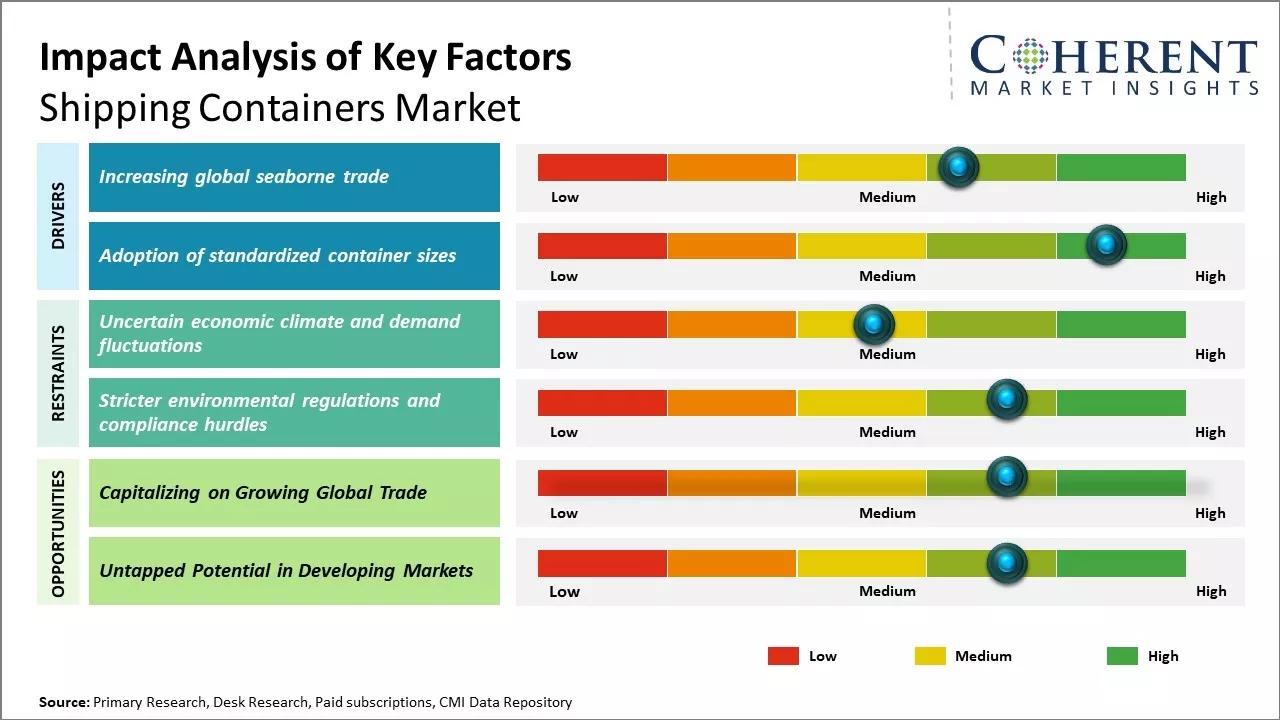
Discover market dynamics shaping the industry: Download Free Sample
The demand for shipping containers is driven by the growth in global trade. Emerging economies in Asia Pacific and Latin America are expected to fuel the demand as their manufacturing and exports continue to increase over the next decade. Adoption of technology and automation solutions for container handling is also expected to drive efficiencies and reduce costs. However, concerns around global trade conflicts and economic uncertainty pose challenges and risks to the future growth projections of the shipping containers market.
Increasing global seaborne trade
The shipping containers market is closely tied to the development of global trade and freight transportation volumes. Over the past few decades, steady growth in international seaborne trade was witnessed driven by a variety of factors such as globalization of economies, outsourcing of manufacturing to low labor cost countries, and improvements in cross border logistics infrastructure. As global trade agreements have expanded trade between nations, manufacturers are increasingly sourcing raw materials and components from around the world. This has led to a skyrocketing demand for containerized cargo shipments by sea. Major trade lanes such as transpacific, Asia-Europe, and transatlantic routes have seen massive growth in container traffic volumes annually. Shipping lines have increased fleet sizes and ordered new vessels with higher container capacities to benefit from economies of scale. This has encouraged strong demand for new and replacement containers among shippers. The trend of rising globalization is expected to continue in the foreseeable future as developing economies urbanize and integrate further into global supply chains. This will support continuous growth of worldwide seaborne trade and underpin demand for shipping containers.
In May 2022, Mazagon Dock Shipbuilders ventured into container manufacturing following an order from the Container Corporation of India Ltd (CONCOR) for 2,500 cargo-carrying steel boxes. Valued between INR 35 million (USD 0.43 million) and INR 40 million (USD 0.49 million) each, this deal addresses the shortage of containers faced by Indian exporters during the COVID-19 pandemic. CONCOR introduces 12 feet containers for the first time in India, aiming to enhance local production to meet demand.
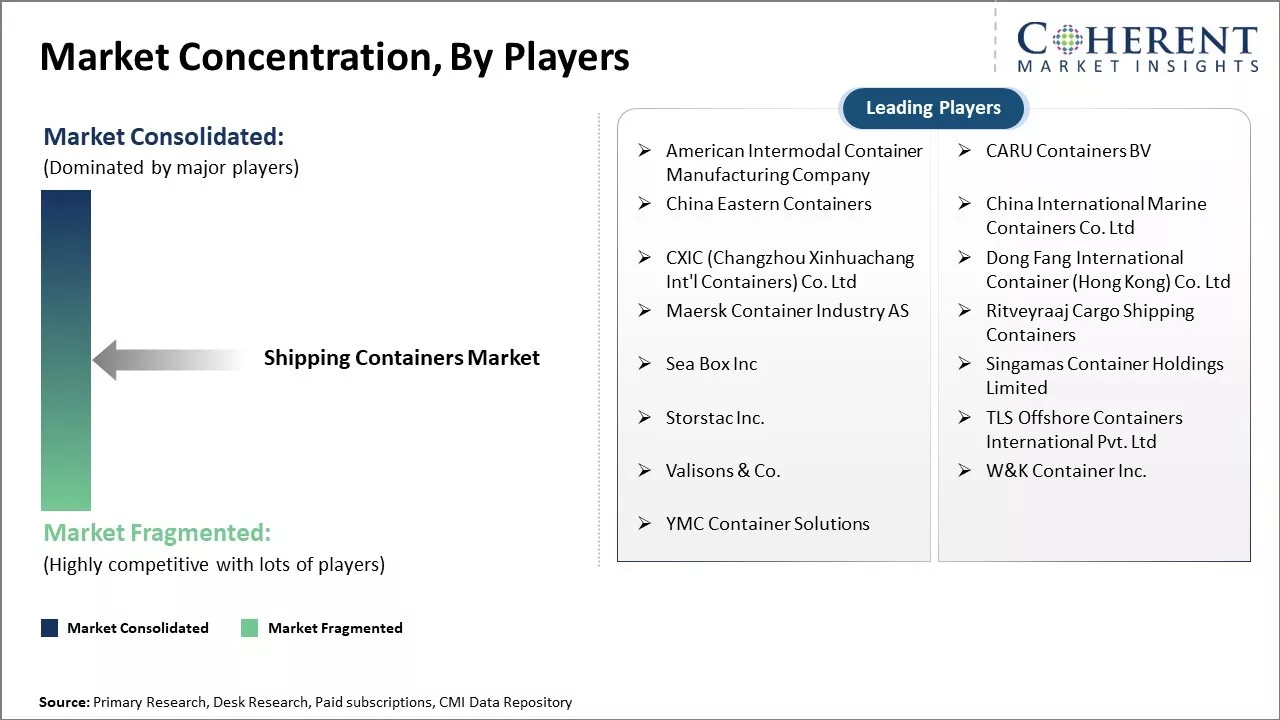
Get actionable strategies to beat competition: Download Free Sample
Adoption of standardized container sizesThe widespread adoption of standardized container sizes by the international shipping industry has greatly simplified container handling logistics worldwide. Major container sizes that have become globally accepted include 20 feet (6.1 m), 40 feet (12.2 m), and 45 feet (13.7 m). This has allowed intermodal transfers between ships, trains, and trucks with ease. Empty containers can be repositioned quickly to areas of demand. Multinational ocean carriers, port terminal operators, and inland freight hubs have invested heavily in container handling equipment and infrastructure compatible with standardized dimensions. Shippers also prefer containerization due to reliability of schedules and transport costs. The standardization has maximized container utilization rates by allowing loads to be consolidated efficiently. As global supply chains continue to ramp up volumes traversing vast distances, maintaining standardized container sizes remains crucial to the facilitation of just-in-time logistics. This creates a steady replacement demand as older containers eventually need to be retired and upgraded to modern specifications supported by global intermodal infrastructure.
In March 2023, GenFlat Containers, a company based in California, U.S., introduced a more sustainable collapsible Marine Container. This innovation replaces traditional standard marine containers, collapsing four empty containers into the space of one standard container in just 80 seconds. This solution from GenFlat Containers reduces repositioning costs, storage space, and carbon emissions by an impressive 75%, achieved through a partnership with CIMC in Dalian, China, for manufacturing.
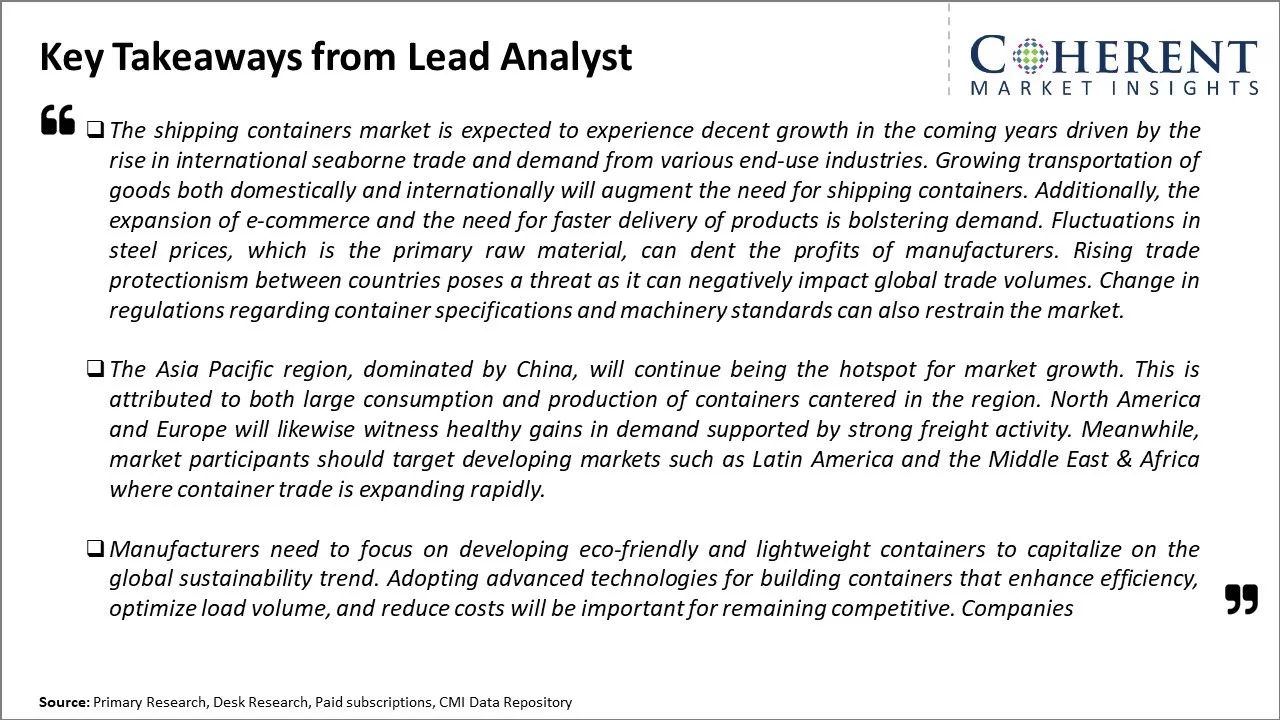
To learn more about this report, Download Free Sample
Market Challenges: Uncertain economic climate and demand fluctuationsThe shipping containers market faces several challenges. Global trade uncertainties and fluctuations in demand create unpredictability for container manufacturers. Shipping costs have also risen in recent years. Additionally, growing environmental regulations pose compliance issues as more restrictions are placed on greenhouse gas emissions. Containers must be adapted to use alternative fuels to power ships. However, new technologies may help alleviate these challenges over time.
Market Opportunities: Capitalizing on growing global trade
As global trade volume increases in the coming years, the demand for containers is projected to grow. Expanding into developing markets offers chances for expansion. Further, sensors and internet-of-things solutions applied to containers can provide data insights to supply chain players. More automated terminals and ports also promise efficiency gains. Outsourcing container services and the shift to reusable products as a service both present new business models to explore.
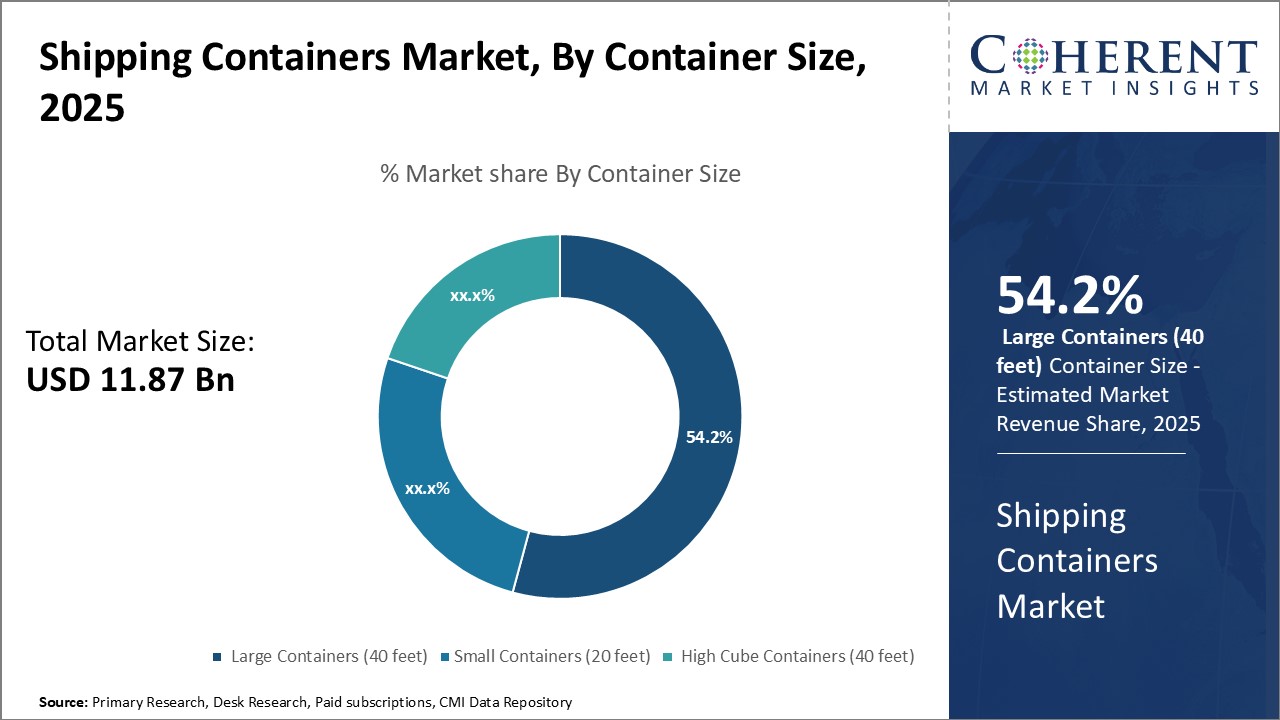
Discover high revenue pocket segments and roadmap to it: Download Free Sample
Insights, By Container Size - Economies of Scale Drive the Adoption of Large ContainersIn terms of By container size, large containers (40 feet) are expected to contribute the highest share of 54.2% in 2025, owing to their ability to provide economies of scale to shippers. Compared to smaller containers, large containers allow shipping more cargo per container. This significantly reduces the cost per unit of cargo transported. Shippers are able to transport 50% more cargo volume in a 40-foot container compared to a 20-foot container. This translates to lower transportation costs for shippers. Additionally, large containers provide versatility since they can be divided to transport various types of cargo configurations. Their standardized design also allows for seamless intermodal transfers between ships, trucks, and trains. This ease of multimodal transportation drives the preference for large containers among shippers.
Insights, By Container Type - Dry Storage Containers See the Greatest Demand
In terms of container type, dry storage containers are expected to contribute the highest share of 65.46% in 2025, owing to the large volumes of general cargo transported globally via sea routes. A wide variety of bulk commodities and packaged goods are transported internationally in dry containers without any refrigeration or controlled atmosphere requirements. This includes shipments of goods such as garments, consumer products, machinery, and millwork. The flexibility and relatively low costs of dry container shipping have made it a preferred solution for the transportation of general and non-perishable cargo. Their universal suitability for most non-hazardous dry goods has resulted in the growing demand and uptake of dry storage containers.
Insights, By End-use Industry - Food and Beverages Sector Relies Heavily on Shipping Containers
In terms of end-use industry, food & beverages is expected to contribute the highest share of 31.79% in 2025, owing to rising global trade in food and beverage products. International food and drink manufacturers depend on reliable, high-volume container shipping services to transport their products across the world. Majority of raw materials used in food production like grains, fruits, and sugarcane are imported via shipping containers. Likewise, finished food products are exported globally in containers. Refrigerated containers allow temperature-controlled transport of perishable foods over long distances. Time-sensitive and high-value beverages also rely on consistent container shipping. Factors like changing consumer diets and growing import/export of specialty/artisanal food items drive the container demand from the food and drinks industry.
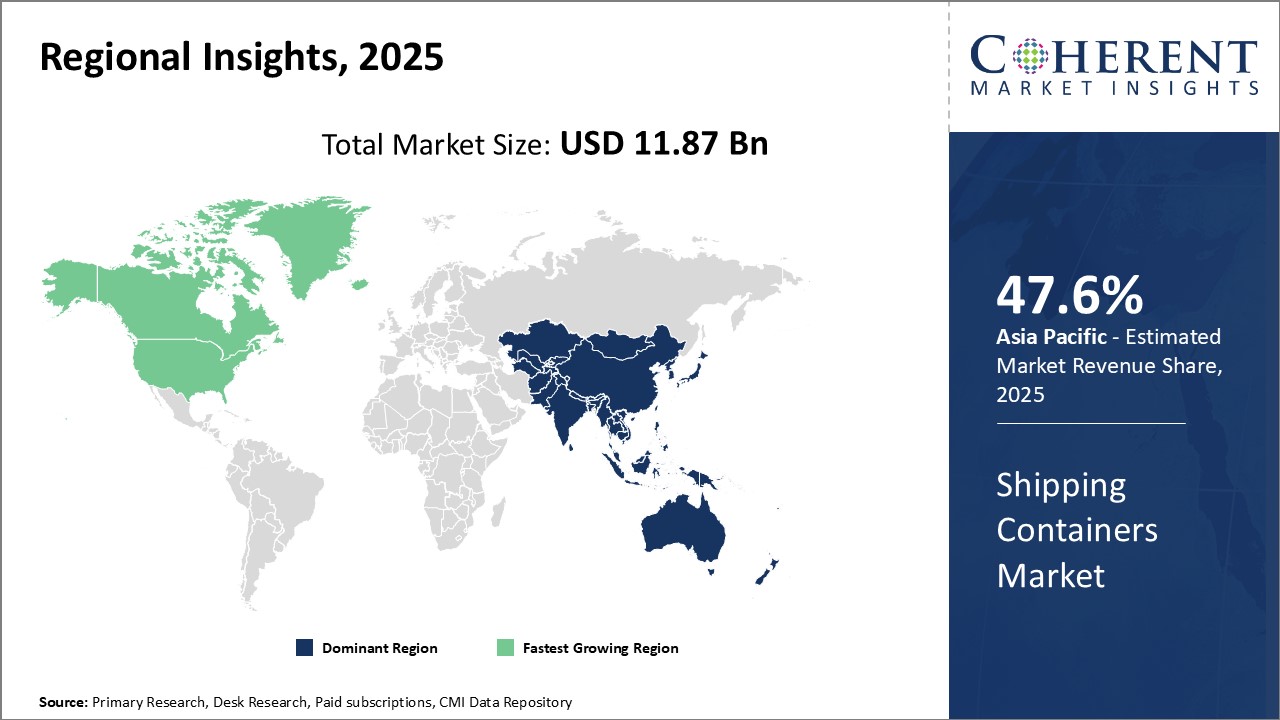
Need a Different Region or Segment? Download Free Sample
The Asia Pacific has been dominating the global shipping containers market and is estimated to keep dominating with 47.6% of market share in 2025, on the back of rising trade activities. China, with its mammoth manufacturing base and export powerhouse status, handles the largest volumes of containerized cargo in foreign trades. It is followed by other Asian countries like Korea, Japan, India, and ASEAN nations that are witnessing increasing adoption of sea-faring containers for transportation of goods. The availability of cheap labor and resources in Asia has attracted global manufacturers to set up production facilities locally. This has bolstered intra-Asia and export containerized trade.
Moreover, Asian countries are also investing heavily in developing new container terminals and expanding the capacity of existing ports to keep up with escalating trade. For example, China and India are constructing several mega ports to accommodate larger container vessels. This positive infrastructure growth is facilitating regional market expansion. Overall, Asia's growing importance in global trade and manufacturing will continue propelling the demand for shipping containers in the foreseeable future.
The North America region has emerged as the fastest growing market for shipping containers and is expected to grow at a CAGR of 6.64% in 2025, with the presence of some of the largest container transportation companies and busiest seaports, the region accounts for a major share in the global container trade. The U.S., in particular, handles the largest containers traffic globally owing to its extensive trade relationships around the world. Key U.S. gateways on both coasts like Los Angeles, Long Beach, New York, and New Jersey are among the busiest ports worldwide. Also, the region is home to the headquarters of leading container lessors and manufacturers who cater to the strong domestic as well as export-import demand.
Another significant factor contributing to North America's growth is its well-established intermodal infrastructure for seamless transfer of containers between ships, trucks, and railways. This integrated supply chain network allows containers to reach inland destinations quickly and efficiently. Moreover, the regional market benefits from stable macroeconomic conditions, high per capita income, and high consumer demand compared to other parts of the world. These demand-side forces have helped maintain container traffic volumes at healthy levels.
Shipping Containers Market Report Coverage
| Report Coverage | Details | ||
|---|---|---|---|
| Base Year: | 2024 | Market Size in 2025: | USD 11.87 Bn |
| Historical Data for: | 2020 To 2024 | Forecast Period: | 2025 To 2032 |
| Forecast Period 2025 to 2032 CAGR: | 5.5% | 2032 Value Projection: | USD 17.28 Bn |
| Geographies covered: |
|
||
| Segments covered: |
|
||
| Companies covered: |
American Intermodal Container Manufacturing Company, CARU Containers BV, China Eastern Containers, China International Marine Containers Co. Ltd, CXIC (Changzhou Xinhuachang Int'l Containers) Co. Ltd, Dong Fang International Container (Hong Kong) Co. Ltd, Maersk Container Industry AS, Ritveyraaj Cargo Shipping Containers, Sea Box Inc, Singamas Container Holdings Limited, Storstac Inc., TLS Offshore Containers International Pvt. Ltd, Valisons & Co., W&K Container Inc., and YMC Container Solutions |
||
| Growth Drivers: |
|
||
| Restraints & Challenges: |
|
||
Uncover macros and micros vetted on 75+ parameters: Get instant access to report
Share
Share
About Author
Gautam Mahajan is a Research Consultant with 5+ years of experience in market research and consulting. He excels in analyzing market engineering, market trends, competitive landscapes, and technological developments. He specializes in both primary and secondary research, as well as strategic consulting across diverse sectors.
Missing comfort of reading report in your local language? Find your preferred language :
Transform your Strategy with Exclusive Trending Reports :
Frequently Asked Questions
Joining thousands of companies around the world committed to making the Excellent Business Solutions.
View All Our Clients